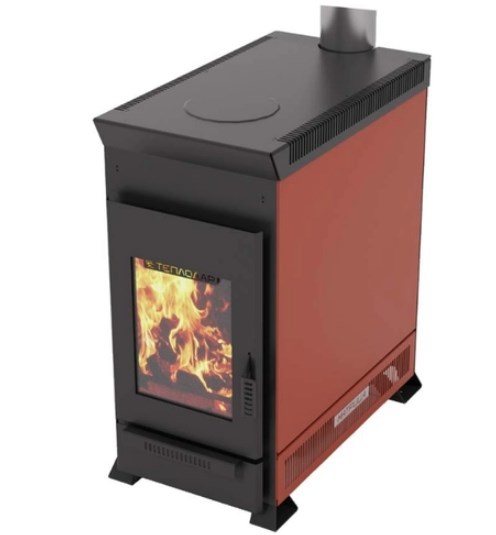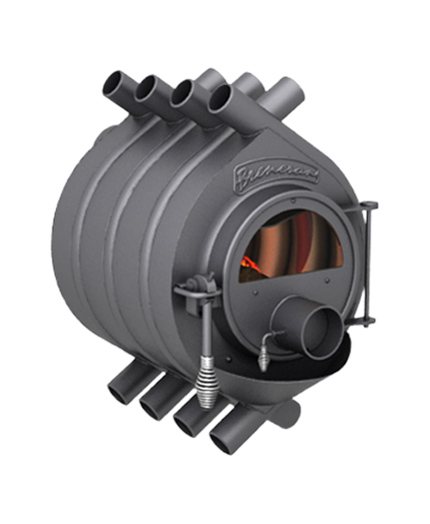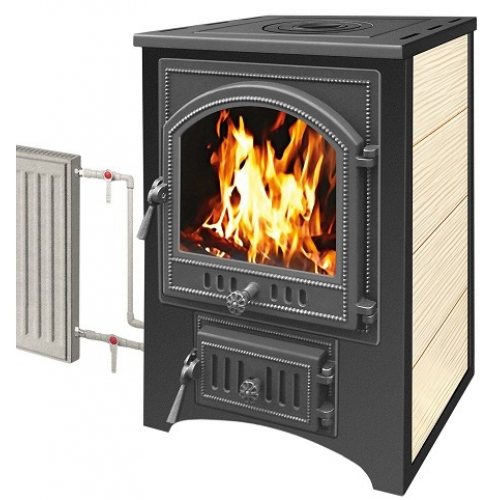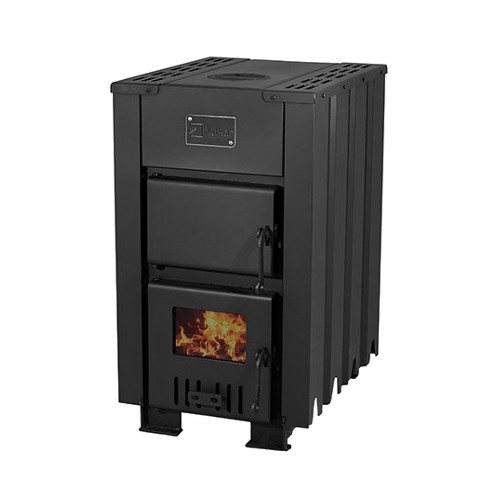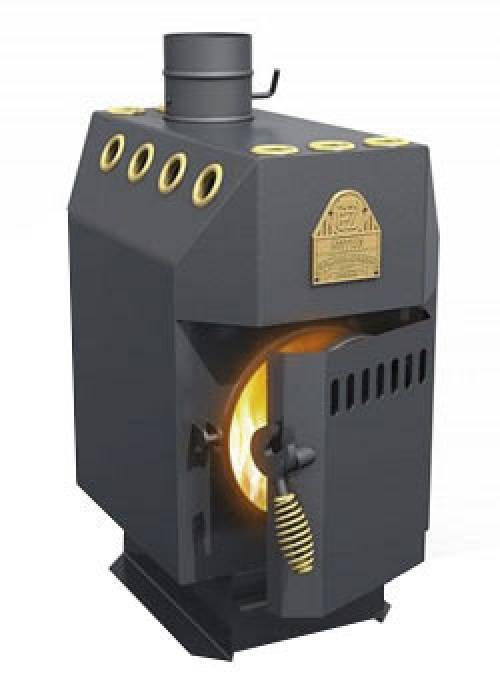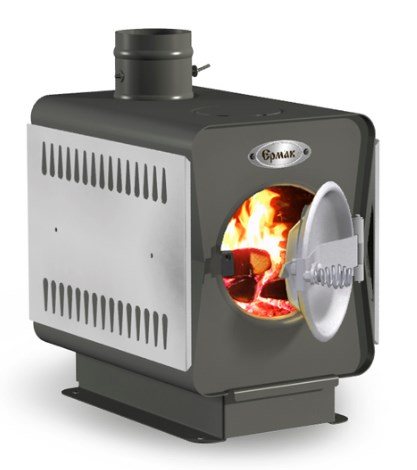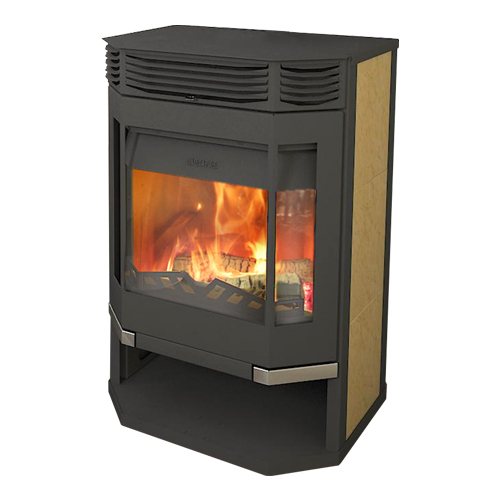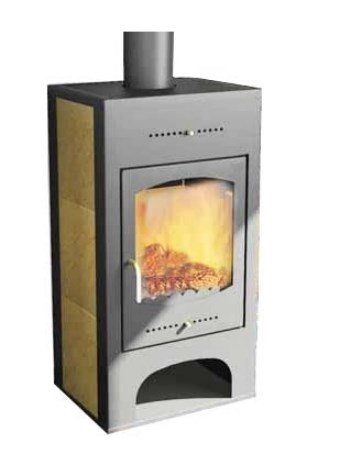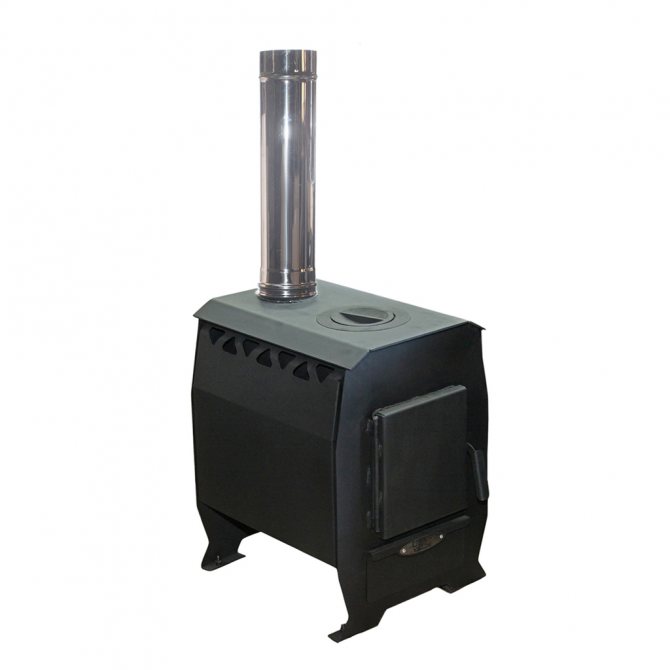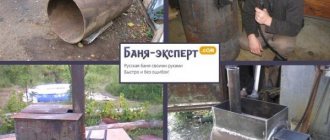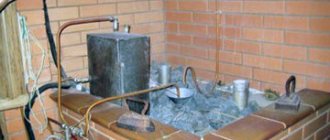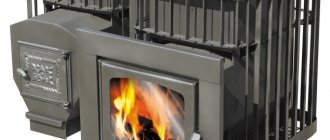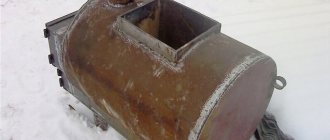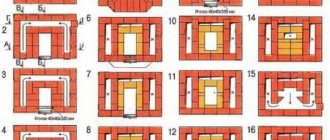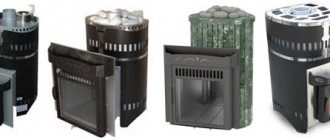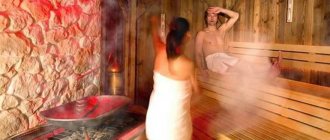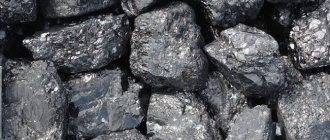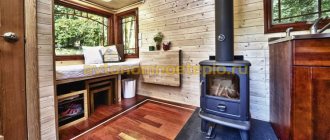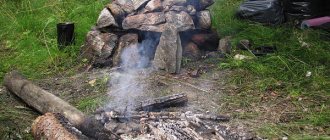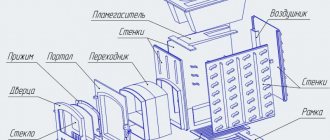Stove heating is considered one of the most common, economical and simple ways of autonomous heating for private homes .
Especially for heating large rooms, well-known manufacturers have developed many thoughtful models of wood-burning stoves for every taste and budget.
Modern devices are safe to use and do not require lining or strengthening the foundation, which means that the user will not have any problems during the installation and operation of heating equipment.
Page navigation:
Peculiarities
A distinctive feature of these heating partitions is the slow burning of wood. The fuel in them simply smolders and does not burn. This effect is achieved due to the ability to regulate the amount of incoming air.
The combustion chamber of the heater is divided into two compartments and is completely sealed; air is forced into it. The firebox is large enough to accommodate a lot of firewood.
The duration of work on one bookmark is ensured due to the peculiarities of the combustion process - the fuel, in conditions of lack of oxygen, begins to slowly burn out from above, gradually capturing the lower layers.
Advantages and disadvantages
The list of advantages of using a wood stove for heating private houses and summer cottages includes:
- saving money on the construction of a massive foundation, since the devices weigh little and have compact dimensions;
- regulation of the combustion process;
- high efficiency (up to 80 - 85%);
- attractive appearance, due to which they fit harmoniously into any home decor;
- multifunctionality - they can not only heat the room, but also heat water and be used for baking and preparing various dishes;
- Possibility of installation in any room with a chimney;
- durability (service life of devices is at least 50 years);
- relatively low cost;
- high efficiency, since the stove can operate for a long time on one load of firewood.
The disadvantages include:
- the need for regular chimney cleaning;
- high requirements for wood moisture content;
- difficulty in setting oven modes.
Types of long-burning wood stoves
Long-burning wood stoves for heating a home are divided into several types. They are made from different materials, have their own design features, and use one or more types of fuel.
Material
An economical stove for a summer residence can be made from:
- Steel. Metal wood-burning stoves are made of heat-resistant steel and can quickly heat rooms, but due to the small thickness of the material they are not able to retain this heat for a long time. Stainless steel appliances can hold heat for the longest time, but they have weak points - seams that may not withstand rapid heating and may crack.
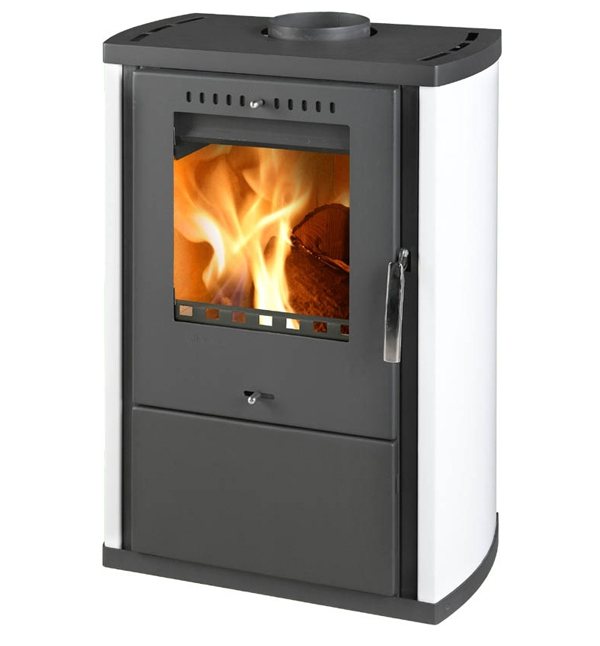
- Cast iron. Cast iron products have a compact design that allows installation in any part of the cottage and in a small room. To remove combustion products, they are equipped with a corrugated chimney or sleeve. They are able to quickly warm up a room and retain heat for a long time.
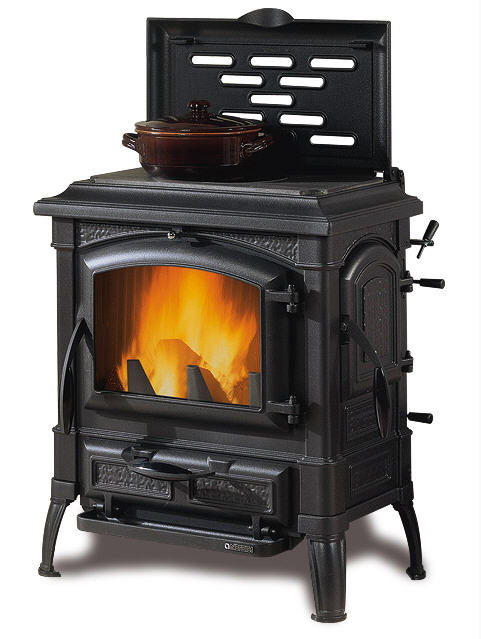
- Brick. A brick wood stove is the most reliable, but also expensive option. Heating of the stove body occurs due to the serpentine chimney over a longer period of time, but this disadvantage is compensated by long-term heat retention. Typically, such appliances are equipped with a hob that allows you to cook food. There are more massive brick structures - Russian stoves with a stove bench, which heat fairly large rooms, as well as small stoves - fireplaces, designed for heating and decorating the interior.
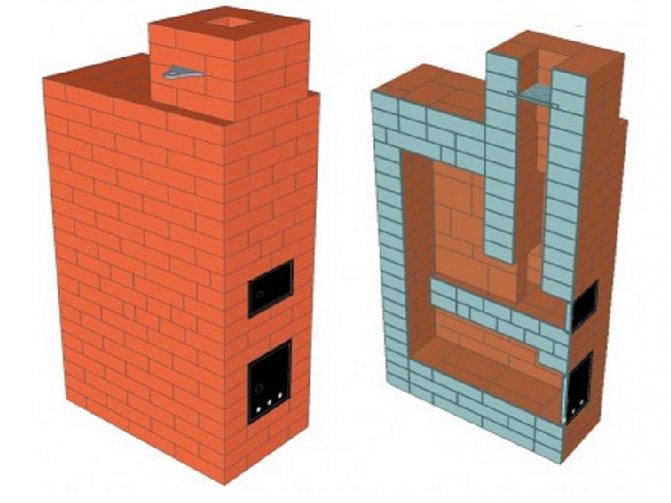
- Ceramics. Expensive devices with a high-quality design, the body of which is made of fire-resistant steel, the outside is lined with ceramics, and the inside is lined with fireclay.
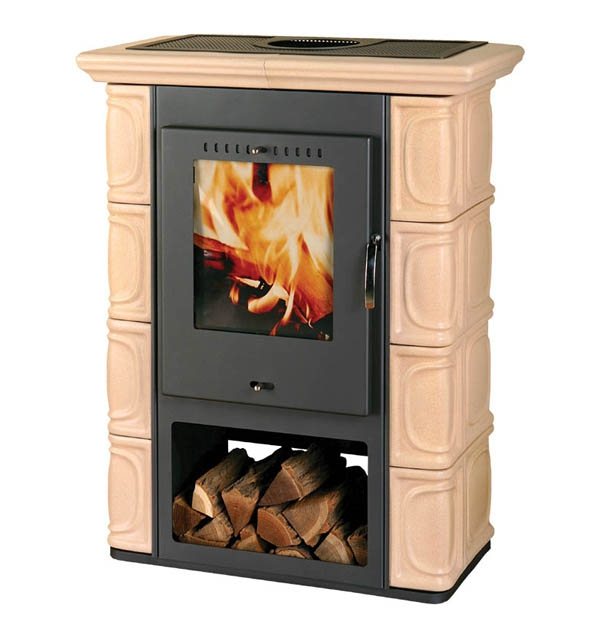
Fuel type
Fuel for long-burning furnaces can be one type or several types. Depending on this, the devices are:
- strictly wood-burning, working only with wood;
- solid fuel, supporting the combustion of any solid fuel: firewood, coal, fuel briquettes, wood chips and sawdust;
- gas-fired, using wood or gas for combustion;
- electric wood-burning - with a built-in electric boiler.
Size
Long-burning wood-burning home stoves are small in size.
On average, metal appliances are produced:
- width - from 510 to 1050 mm;
- length - 300 - 800 mm;
- depth - 400 - 750 mm.
The dimensions of the brick device depend on the chosen model and the free space in the room.
Other criteria
Such furnaces also differ in the method of obtaining thermal energy:
- direct-flow - heat generation occurs only during the combustion of solid fuel;
- gas generators - the combustion chamber is divided into two sections, one is loaded with firewood, the other is designed to burn out the wood gas released during the combustion process.
Depending on the design features, wood stoves are:
- ordinary;
- with hob;
- with oven;
- stoves - fireplaces.
According to the method of heat transfer, devices are divided into:
- convection - the movement of cold air begins from the floor, then it is heated in the combustion chamber and goes through the upper part of the body and the chimney to the street;
- with a liquid heat exchanger - they have a special heat exchanger installed in the combustion chamber or on a pipe, to which the circuit of the liquid heating system is connected. Long-burning heating stoves with a water circuit heat rooms in large buildings more efficiently.
Criteria for choosing a wood stove
When choosing, you should pay attention not only to the material. It is, of course, important, but the most important criterion is the power of the furnace.
Choosing a sauna stove by power
It will not be possible to combine all the requirements into one and give out numbers. The power should be optimal for a particular case. There are 2 common mistakes at this stage:
- The oven is too powerful
- An oven that is too low-power is selected.
In the first case, the air will be hot and the stones will be cold. There is no point in pouring water over cold stones: the steam will be similar to what we see from a kettle. Or maybe it won’t exist at all. In the second case, a low-power stove will work hard to warm itself and the room to the required temperature level. It won't last long.
Power should be optimal for a particular case
To make a decision, you need to calculate the volume of the room. This is done simply, as in a school problem:
- Multiply length, width and height.
- Then we inspect the walls and ceiling for uninsulated areas. We calculate their area, again, using the formula known from school: S = a · b, where a and b are the length and width.
- Add up the resulting areas and multiply by 1.2.
- Next, add up the volume and the resulting sum of areas.
- If there is a glass door, multiply the result by 1.5.
- The power itself is calculated based on 1 kW per 1 m³.
Type of fuel
Wood- burning stoves stand out
,
electricity
, as well as gas and combined.
For all the same basic parameters of the stove: body material, fuel, power, heated volume, and so on. It is worth analyzing the most important parameters, based on which you will need to make a choice.
Location
Here the features of the construction will be important, namely, whether the bathhouse consists only of a steam room and a dressing room or has extensions. In the first case, the only location option is to install the stove in the steam room. If the bathhouse is divided into washing rooms and a steam room, then the stove is placed so as to heat both at once. Accordingly, it will be important to choose a stove whose design takes this into account.
Fuel
Based on the fuel used, there are three main categories of stoves:
- Wood-burning - there is no need to complain about the lack of wood in Russia, and therefore wood-burning stoves remain popular. With them you can best feel the atmosphere of a classic bath - the steam is exactly as it should be, and the smell of firewood is, after all, an important part of it. But such a stove takes a long time to heat up, and it needs a chimney.
- Gas - they heat up quickly, the fuel is cheap, and you don’t have to bother with it like with firewood. The disadvantage is that you must obtain permission to install such a stove, since if installed incorrectly or poorly maintained, it can be dangerous.
- Electric – Easy to install and maintain, these stoves are best suited for heating small spaces. The fact is that constantly heating a large bathhouse with electricity will be too expensive.
There are also hybrid options that can switch from one type of fuel to another if necessary.
Heated volume
Any model is designed to heat a room of a certain volume. There are no special tricks here: you just need to choose it based on the volume that will need to be heated.
Burning time
In addition to the usual ones, there are also models with the ability to burn for a long time. If you often need to add fuel to simple ones, then these can work on one tab for many hours - sometimes 8-10. They have two modes - normal, in which heating is carried out, and long-burning - in which the temperature is simply maintained.
Housing material
Based on the material from which the stoves are made, there are three types:
- Brick - they need to build a foundation, they have a complex structure, and they will take a long time to heat up. Therefore, gradually fewer and fewer of them are being built, but they also have advantages: after warming up, they will retain heat for a long time, and are effective for large areas.
- Cast iron ones weigh a lot, which is why they also require a foundation, but due to the material they accumulate heat very well and are released by gentle heating of the air. A cast iron stove can last for many years.
- Steel ones are the easiest to install and can be very compact. A foundation is not needed, which in many cases predetermines the choice in their favor. Steel is inferior to cast iron due to the fact that the thickness of the walls of stoves made from it is smaller, it cools quickly, and heating will not be as pleasant - but these disadvantages can be smoothed out if you purchase models made of chrome fabric and with thicker walls.
We invite you to familiarize yourself with a DIY wooden entrance door for a summer house
Power
One of the key parameters is that it is best to determine how powerful the stove will be needed at the very beginning, and then build from there. It is important that the power is accurately calculated: if it turns out to be lower than required, then the stove will have to work for wear and tear and will soon need to be replaced, but you should not take too much power - the air in the steam room in this case heats up too quickly, and even when it becomes hot , the stones will not warm up.
Which stove to choose for your summer house?
A wood-burning stove for a summer residence should have the simplest possible design and be safe to use. In addition, you should consider:
- its purpose - whether the device will be the main or backup source of heat, used exclusively as a heater or part of the decor of the cottage;
- performance—the power should be sufficient to fully heat the structure. It is determined from the ratio of 1 kW per 10 m² of area plus 10-15% of the reserve;
- dimensions - if the area of the country house is small, then not every device will be suitable for it in size;
- volume of the combustion chamber - a larger firebox can accommodate more firewood;
- the ability to perform additional functions (the presence of a hob, a tank for heating water and an oven);
- its ability to support combustion, not only of firewood, but also of wood waste in the form of pressed briquettes, wood chips, etc.;
- type of heating system - a number of models are not designed for connection to a closed circuit of radiator systems.
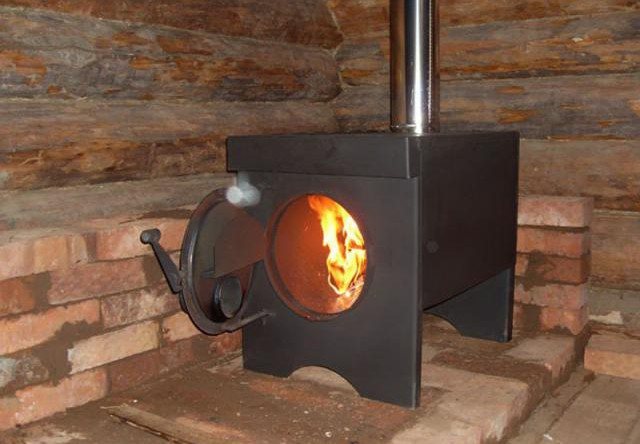
Choosing a stove for home and garden
You must have an adequate supply of clean, dry wood for your stove.
The best types of wood used for lighting stoves and fireplaces are the following:
- red maple.
- Beech
- Oak.
Hardwoods (like those listed above) will give you the most bang for your buck by burning longer and producing plenty of heat. These species are readily available in northern Wisconsin, but you will need to do some research to find what is available in your area.
You can prepare such fuel yourself, having previously obtained all the necessary permits, or buy it in ready-made or partially finished form.
Many people use trees that die right on their property as fuel. These can be oaks, birches and other trees and bushes. Softwoods burn quickly and produce less heat, which means you need to refill frequently and use more wood overall. (Note: Pine burns well, but it produces intense heat and very high temperatures. It also produces a lot of smoke, soot, and soot when burned.)
Firewood should be "seasoned" or dried for at least six months to a year before being burned to reduce the amount of creosote in the chimney and air pollution. Green (out of season) wood will burn slowly and produce a lot of smoke and particulates. When they accumulate in your chimney, it increases the risk of a chimney fire. This means you should plan a year in advance for next winter.
Choose a suitable location for storing wood.
From us, you can buy wood-burning stoves in a classic style, such as: Castellana - Sergio Leoni, Defiant Vermont Castings, as well as more modern fireboxes in modern and high-tech style: DONON, Arcade (painted metal) - Keddy.
Such a fuel storage room provides good air circulation and protection from rain and snow.
You need to plan for proper wood storage
To dry (dry) wood needs good air circulation. This means that the shed must be airtight and well ventilated at the same time. You should also find something to put the wood on to keep it off the ground. Old treated 4x4 blocks are also often used for kindling heating units. Thanks to correctly and correctly selected materials, you will ensure that the fuel is quickly prepared and fully dried, with the possibility of further using such firewood to kindle your heating unit.
Heating on a wood stove is a labor-intensive process that requires strength, certain skills and knowledge.
One thing that most people don't think about is how much time you'll have to spend cutting and preparing wood to heat your home. If you have back problems or other health problems, you can buy wood from a lumberjack. There is also the task of maintaining the fire. Most wood burners require attention every 6-8 hours, possibly longer if you have a good stove or open boiler.
On the other hand, you can skip the gym and exercise at home.
Wood stoves are not cheap.
The initial cost of a wood stove will be around $3,000 plus installation. Resale value drops quickly, so unless you think you won't be using this kindling stove very often, it's probably worth considering a cheaper option. (You can buy a stove that has already been used, but during the operation of such a heating unit no one can guarantee you its proper and correct operation). Quality wood cutting tools also cost money, and with tools you usually get what you need. It is important to choose everything you need to heat your house with a stove, clean it and maintain it, and this is a considerable investment and it should also be thought out.
Pellet stoves may be a better choice for urban areas because you don't have to dry and store a year's supply of fuel. Outdoor boilers are another option. Stoves operating on pellets do not require fuel, as it is sold in any specialized store.
Masonry heaters are another option, but they can be more expensive than conventional wood or pellet stoves.
It is important to purchase in advance tools such as a saw and an ax that will be intended for cutting wood. To ensure that such a process does not create any special problems, it is better to give preference to electric variations that run on mains power or gasoline. Such fuel and resources will always be available.
Heating stove manufacturers
Important criteria for choosing a stove are also the price and reputation of the manufacturer. The Russian market offers a wide range of budget and premium-class stoves from domestic and foreign companies. Products from the following manufacturers are especially popular:
- Teplodar (Russia). In recent years, long-burning wood stoves for home heating produced by this company have become the most popular on the market. The company produces heaters of seven modifications. If you need a device for quickly heating a room, then you should buy a cast iron stove “Sibir” at a price of 18 - 21 thousand rubles. If you are interested in an unusual design, the company can offer a number of models, including “Rus Panorama” and “Siberia Panorama” with a lower price - 12 - 17 thousand rubles.
- Termofor (Russia). For the manufacture of Termofor stoves, heat-resistant steel and high quality materials are used. The unique dual combustion system allows them to quickly warm up and distribute heat by convection currents throughout the entire area of the room. Some devices have a soot removal system. The price of simple Termofor stoves varies in the range of 10 - 14 thousand rubles, the price of multifunctional models can be 45 thousand rubles and more.
- Ermak (Russia). The special chimney system of wood-burning stoves for the Ermak bathhouse promotes excellent air circulation and good heat exchange in a short operating time. The price of the devices is 12 - 40 thousand rubles.
- HARVIA (Finland). The stoves are made of high-grade stainless steel. The boilers have a special remote firebox, are very economical and durable, and can quickly heat the room. On average, Harvia stoves cost 25 - 45 thousand rubles.
- KASTOR(Finland). For the manufacture of the case, high-quality hardened steel with a thickness of 5 - 8 mm is used, which ensures reliable and long service life of the device. The efficiency is 75%. The Kastor wood stove is equipped with a ventilation and filtration system. The prices of stoves from this company reach 120 thousand rubles.
The best combined sauna stoves (with tank)
Wood heating has a relatively low efficiency, but bathhouses, especially in the North, are still usually heated with logs. For this reason, we have compiled a rating of wood-burning models.
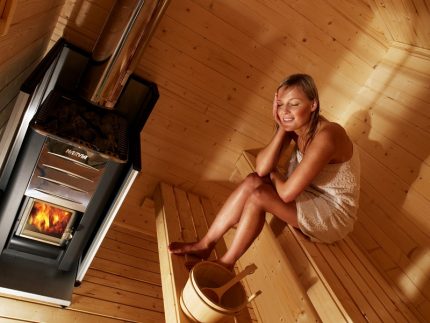
The presented devices differ in design, characteristics, dimensions, functionality, and materials of manufacture, but all are fireproof and designed for heating a steam room
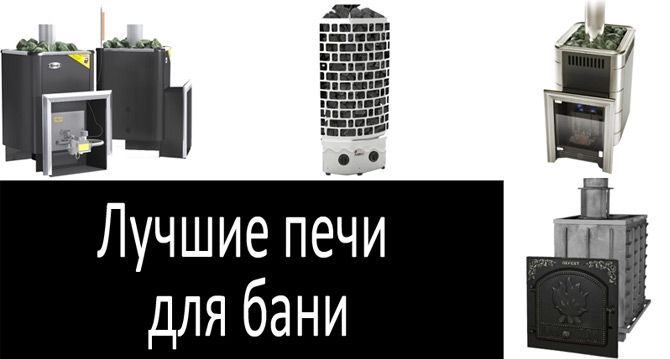
The TOP includes stoves from well-known manufacturers that sell well and have many positive reviews.
The Finns are real pros in the production of high-quality equipment for baths and saunas, and the M3 model is another confirmation of this. Occupying a small area on the floor, the heater for a Russian bath has a vertically elongated body, so it evenly warms the room.
A special open compartment is loaded with 30 kg of stones, which must be purchased separately. The design is designed in such a way that maximum heat transfer occurs and the stove remains hot for a long time.
The oven is compact and has a nice design. The body is painted in neutral colors – black and steel. The paint is heat-resistant and does not lose its protective qualities and appearance over time. Flames are visible through the heat-resistant glass.
Technical specifications:
- installation method: wall-mounted;
- heating power – 16.5 kW;
- material of manufacture – steel/glass door;
- designed for volume – 6-13 m³;
- firebox - without removal;
- water circuit - no;
- heater – open, 30 kg.
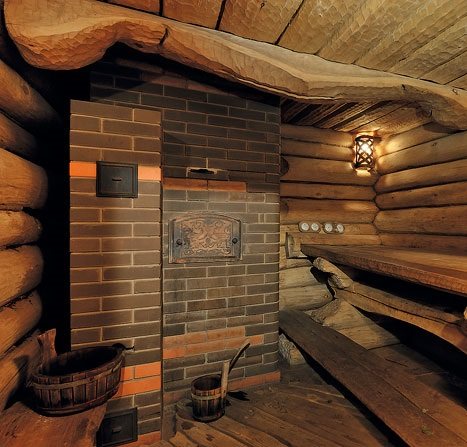
According to reviews, the stove is beautiful, economical and quickly warms up the room. Although it is not intended for connecting a water circuit, it can be supplemented with a water tank, which is purchased separately and mounted in the pipe. If you need a water heating circuit, we recommend that you familiarize yourself with the rating of the best furnaces with a water circuit.
The negative point is low efficiency, only 67%. The ash removal scheme has not been thought through - during operation and during cleaning, some of it ends up on the floor.
The Geyser series of the Termofor brand has a special feature - a combined heater. An interesting design solution allows you to make the internal steam generation system more efficient, light the stove and heat the steam room to 100°C in about an hour. This applies to all 4 varieties of 2014 - Vitra, Carbon, Inox, Carbon Vitra.
There are more than a dozen different modifications on the market, the body of which is made of chrome-plated steel. The color of the convector coating can be different: terracotta, anthracite, beige, chocolate. The door is made of either glass or stainless steel.
- installation method: wall-mounted;
- heating power - no data;
- material of manufacture – steel/glass or steel door;
- designed for a volume of 8-18 m³;
- firebox – with the possibility of removal;
- water circuit - yes;
- heater – closed/open, 63 kg.
Consumers like that the stove can be heated with logs, briquettes, and pellets. The central top location of the chimney greatly simplifies installation. Ash can be removed during the combustion process thanks to the retractable drawer design. The open part of the heater can be used to steam a broom.
The complaints relate mainly to the service life. Users complain about the heater burning out quickly. After 3 warranty years it becomes unusable.
The Harvia brand is truly loved by customers and popular, despite the high prices of the products, so there is another, more powerful and productive model in the rating. It is capable of heating a fairly large steam room - up to 24 m³, so if the bathhouse is intended for relaxation with a large family or company, this is a good option.
The maximum open heater is made in the form of a metal mesh in the shape of a barrel, allowing you to load 200 kg of stones. Robust design recommended for commercial use.
- installation method: wall-mounted;
- heating power – 21 kW;
- material of manufacture – steel/glass door;
- designed for a volume of 10-24 m³;
- firebox – with the possibility of removal;
- water circuit - no;
- heater – open, 200 kg.
Buyers appreciated the beautiful design of the fireplace-type firebox, thanks to which you can watch the burning of logs, as well as the interesting and simple design of the heater-basket. The double combustion system increases the time of using the steam room with a minimum number of bookmarks.
The main negative factor preventing anyone from purchasing a stove is the high cost - almost 40 thousand rubles.
Cast iron model designed for self-installation in brickwork. Thanks to the elongated combustion channel, it can be moved into the room adjacent to the firebox. The walls of the case have a thickness of 10-60 mm, which indicates their reliability and minimal risk of burning. The parts are solid, made of SCh-20 cast iron with chrome, there are no seams or joints.
A gas afterburning system, a flame arrester and a large-volume heater allow you to increase the productivity and burning time of firewood.
- installation method: wall-mounted;
- heating power – 8 kW;
- material of manufacture – cast iron/cast iron door with glass;
- designed for a volume of 15 m³;
- firebox – with the possibility of removal;
- water circuit - no;
- heater – open, 180 kg.
The advantage is the material of manufacture – cast iron. It heats up quickly and “gently”, evenly distributes heat. Efficiency reaches 87%, which is a good indicator for wood stoves. Many people like the design of the firebox - traditionally “heavy” for cast iron products. The door is decorated with gilding and ornaments.
The main drawback is that the stove is only suitable for a small steam room. The assembled weight reaches 700 kg, which causes difficulties during transportation and installation.
We suggest you read: Is it possible to insulate a bathhouse from the inside with penoplex?
The domestically produced device features a combined heater, which allows you to increase heating efficiency and maintain stable heat in the steam room for a long time. Designed for a large room, thanks to the remote combustion portal it can heat two rooms at once. Heating to an acceptable temperature takes 1-1.5 hours.
The open part of the heater is made in the form of a basket framing a casing, inside of which there is a closed part. The entire structure is made of steel coated with a heat-resistant black coating.
- installation method – floor;
- heating power – 14 kW;
- material of manufacture – steel/glass or steel door;
- designed for volume – 12-24 m³;
- firebox – with the possibility of removal;
- water circuit - no;
- heater – closed/open, 240-250 kg.
The advantage of the stove is that it can be additionally equipped with a remote water tank of 60-120 liters, which is installed on a pipe either in the ceiling or in the attic. Instead, you can install an easier-to-install, 50-liter mounted tank.
Buyers are not satisfied with the appearance of the stove. Compared to modern modifications of competing brands, it looks too primitive. Some consumers use brick or stone cladding to somehow enhance the design.
An acceptable solution from the Vesuvius company for hot steam bath lovers who want to quickly and inexpensively set up a sauna. The furnace body is made of structural steel with a thickness of 6-8 mm and is designed for long-term operation - up to 10 years. The door, bumper and grate are cast from cast iron.
The heater is an open convection-type casing, or, to put it simply, a volumetric mesh designed to load 110 kg of stones.
- installation method – floor;
- heating power – 12 kW;
- material of manufacture – steel/glass door;
- designed for volume – 6-14 m³;
- firebox – with the possibility of removal;
- water circuit - no;
- heater – open, 110 kg.
A simple budget modification has become popular due to its cost. However, there are other advantages - good heating of the steam room, beautiful door design, convenient ash tray cleaning system.
The disadvantage is the material of production. You can already guess from the price that there is a risk of rapid burnout, especially with frequent use. Therefore, we recommend purchasing a stove for summer cottages with seasonal visits.]
A beautiful stove lined with natural stone from the Lamel series. Created using German technology, which is confirmed by a certificate. Meets European safety and effectiveness standards. Economical, suitable for frequent visits to the bathhouse. The heat from one bookmark lasts for 3-4 hours.
It is possible to blow out the heater to remove excess moisture from the steam room. The door is large, fireplace type, made of ROBAX glass. The manufacturer claims that a sauna stove with a closed heater can be used in various modes: bathhouse, hammam, sauna.
- installation method: wall-mounted;
- heating power – 16 kW;
- material of manufacture – steel/glass door;
- designed for a volume of 16 m³;
- firebox – with the possibility of removal;
- water circuit - no;
- heater – closed, 60 kg.
The advantage is the presence of an additional option - aromatherapy. You can add oils with the scent of pine, bergamot, mint to a small container and enjoy a pleasant aroma during a couples session. Stylish design and beautiful firebox are pleasing to the eye.
The disadvantages are the same as with most steel units - the risk of premature burnout with regular use.
Economical model made of structural steel with the addition of 17% chromium. The design is distinguished by a stylish design, rigidity and a well-thought-out heat transfer system. The stove is designed for a limited space, but it is possible to install it in 2 rooms due to the elongated firebox.
A big plus is the ability to connect a water circuit, a mounted or remote tank for heating water. The door with a diagonal of 310 mm is panoramic, equipped with Robax glass.
- installation method – floor;
- heating power – 12 kW;
- material of manufacture – steel/glass door;
- designed for a volume of 14 m³;
- firebox – with the possibility of removal;
- water circuit - yes;
- heater – closed, 40 kg.
The main advantage of the stove is its expanded functionality. You can heat water for showers or to heat adjacent rooms. In addition to water tanks, a steam generator and an additional convector are connected. You can also attach another heater - a hinged one that can hold 40 kg of stones.
The downside is the material used. A steel stove with thin walls can easily be overheated, after which it will become unusable.
The stove is interesting because it has several heating modes. Within half an hour, by adding water, you can create the hottest microclimate with a temperature of more than 100°C for particularly hardy steamers. If a regime is needed, as in a traditional Russian bath, the stove is heated slowly, to 80-90°C.
Harvia Delta D36
| Name | Main characteristics | Price |
| TMF Urengoy | It combines thermal efficiency, safety and reliability, for heating a volume of 12 m³, has a chimney, and its firebox volume is 42 liters. | ₽ 13 010 |
| TMF Taimyr XXL 2020 Inox | For rooms with a volume of up to 24 m³, the model, the firebox has a volume of 40 liters, and the internal heater - 47 liters, dimensions: 645 x 450 x 1010 mm. Made from heat-resistant steel. | ₽ 23 930 |
| Varvara Kamenka | With its help, you can heat up to 24 m³ of area, its weight is 120 kg. | ₽ 14 000 |
| Vesuvius Skif 22 | This 22 kW furnace is designed for heating a volume of up to 22 m³, the steel thickness is 12 mm, and has a “clean glass” system. | ₽ 19 390 |
| Hephaestus PB-04 MS | It has a relatively low power of 8 kW, is designed for a volume of up to 14 m³, has a high efficiency rate of 87%, which is achieved due to the unusual design of the walls. | ₽ 43 130 |
| Harvia Delta D36 | A power of 3.6 kW is enough to heat a room with a volume of no more than 5 m³ and a weight of 8 kg. | ₽ 25 200 |
| Sawo ARIES ARI3-60NB | Compact, power 6 kW, volume up to 8 m³, weight only 13 kg, there is a remote control with which you can set settings. | ₽ 33 990 |
| Ermak Uralochka-20 | It can operate either on wood or on gas, and is made of stainless steel containing up to 17% chromium - thanks to it it is easier to breathe in the steam room. | ₽ 14 880 |
| Hephaestus PB-01 | It can heat up to 50 m³, is made of cast iron, heats up to 750 degrees, providing the ideal atmosphere and light steam in the bathhouse. | ₽ 124 950 |
Popular models
For comparison, the main characteristics of the best 10 models of long-burning stoves are presented in the table:
| Model and price (RUB) | power, kWt | Heating area, m² | Firewood burning time , h | Efficiency, % | Dimensions, cm |
| Teplodar Matrix - 200,
17890 rub. | 20 | 200 | 8 | 85 | 750x370x695 |
| Breneran AOT – 08,
16250 rub. | 8 | 140 | 10 — 12 | 80 | 760x560x610 |
| Vesuvius PC - 01,
18540 rub. | 9 | 150 | 5 | 78 | 813x434x500 |
| Alpina 250,
45870 rub. | 10 | 250 | 15 — 20 | 80 | 970x560x610 |
| Professor Butakov "Assistant Professor",
29800 rub. | 25 | 500 | 10 — 12 | 85 | 570x820x100 |
| Ermak - 70 OV,
7600 rub. | 6 | 30 | 8 — 12 | 80 | 510x320x470 |
| Flama Eldur Keramik Plus, 54,000 rub. | 10 | 200 | 10 — 12 | 73 | 970x730x390 |
| Angara 12 AQUA,
75,000 rub. | 16 | 120 | 12 — 14 | 80 | 1040x700x535 |
| Varta,
RUB 41,200 | 9 | 90 | 6 — 8 | 80 | 1030x550x415 |
| Heat 100,
11,900 rub. | 4 | 30 — 35 | 6 — 8 | 78 | 540x370x500 |
Safety rules when installing the stove
There are risks associated with heating your home with wood.
Clean your chimney every year and check for problems. Improper ventilation can lead to a build-up of carbon monoxide, which can be fatal. (A carbon monoxide detector is a good investment for almost every home, but especially for those who have heating equipment in their home.
Creosote and chimney.
Creosote formation is another problem.
What most people think of as "smoke" is better called "flue gas." This "smoke" or flue gas is released during the initial combustion: "primary combustion". Flue gas consists of steam and accompanying products of combustion and fuel breakdown (evaporated creosote). When flue gas exits a fireplace or wood stove, it is directed upward into a relatively cool chimney where condensation occurs. Like hot breath on a cold mirror, the temperature of the cold surface of the chimney causes the carbon particles in the warm vapor to solidify.
The actual cause of creosote condensation is the temperature of the flue surface at which the flue gas comes into contact. This carbon-based condensation that occurs inside the chimney is creosote. Usually it is black. This may be a fine black dust called soot (stage 1 creosote); or porous and crispy (2nd stage); or it may be resin-like: wet and sticky until it turns into a shiny glaze (stage 3). All forms of creosote can occur in the same chimney system. Whatever form it is in, creosote is highly flammable. If it accumulates in sufficient quantities and ignites inside the chimney, the result is a volcanic fire in the chimney.
Several conditions contribute to the accumulation of creosote:
- The chimney is too large for a wood-burning appliance (for example, without a liner).
- Limited air supply.
- Untreated wood.
- Lower than normal flue gas temperatures (e.g. metal chimney).
Pay attention to the phrase “volcanic chimney” - promptly check and clean the chimney from soot, soot and avoid blockages.
Chainsaws and other cutting tools.
Chainsaws and other wood-cutting tools are dangerous. All these tools must be used with extreme caution. A chain saw is a tool that requires maximum concentration - it is important to be able to use such a tool correctly and safely. It is equally important, when using such tools and preparing wood, to use special equipment, protective clothing and a mask that will cover the face and eyes. Every year, professional loggers die in the forest.
Satisfaction with wood stove heating.
In this article, you were able to learn in as much detail as possible about what every person needs to know before buying or installing a solid fuel stove in their home. Now you also know what the most common problems you may encounter. Many families and entire generations use this method of heating their homes today. It's nice to look at a well-stocked woodpile and know that, no matter what happens with fuel prices, your home will be warm, and that the fire itself won't go bad and put you and your family in danger. Wood-burning stoves are the most efficient because they emit heat that is evenly distributed throughout all the nooks and crannies of your home, allowing them to be heated equally.
What you need to know before buying a long-burning stove:
Requirements for installation in the home
When installing the device, the following conditions must be met:
- at the location of the unit there is a non-flammable, heat-resistant base (metal or stone);
- the distance between the nearest walls and the device itself is 20 cm or more;
- not far from the stove there is a small woodpile for storing firewood and accessories for removing ash;
- there is a chimney with a diameter of at least 150 mm and a height of 3 to 5 m.
- the presence of a metal sheet at least 50 cm wide on the floor in front of the ash pit.
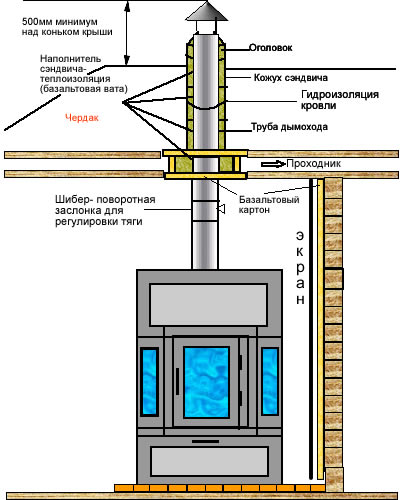
Installation diagram
